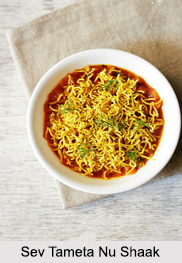 Sev Tameta Nu Shaak is a popular dish of Gujarati cuisine that is sweet and sour tomato curry prepared with tomato, sev, onion and other Indian spices. In this recipe, first tomatoes, onion and spices are sautéed in oil and then steam cooked with water, sev is added only toward its final stage of preparation. "Sev" is a deep-fried, vermicelli-like snack made with gram flour. It should be noted that the tomatoes can be cooked earlier, but the sev should be added just before serving so that it remains fresh and crisp. It is usually served with paratha and "Thepla" for a delicious meal.
Sev Tameta Nu Shaak is a popular dish of Gujarati cuisine that is sweet and sour tomato curry prepared with tomato, sev, onion and other Indian spices. In this recipe, first tomatoes, onion and spices are sautéed in oil and then steam cooked with water, sev is added only toward its final stage of preparation. "Sev" is a deep-fried, vermicelli-like snack made with gram flour. It should be noted that the tomatoes can be cooked earlier, but the sev should be added just before serving so that it remains fresh and crisp. It is usually served with paratha and "Thepla" for a delicious meal.
Sev Tameta Nu Shaak is also known as "Sev Tamatar Ki Sabzi" in Hindi, is made popularly during the Jain festival of "Paryushan Parva" when roots and other vegetables are not included in the diet. Tomatoes are used in most often used as bases for many vegetables and accompaniments. But Gujarati"s have taken it to a next level, by using it as a main course vegetable. This dish is very popular among the Jain Gujarati community has it has no root vegetables, no onion and garlic.
Ingredients:
•Red Ripe Tomatoes - 5 medium size, chopped
•Nylon Sev or Thick Sev - 1/2 cup
•Cumin Seeds - 1/2 tsp
•Mustard Seeds - 1/4 tsp
•Onion - 1 medium size, finely chopped
•Ginger-Garlic Paste - 1 tsp
•Green Chilli - 1, finely chopped
•Sugar - 2 tsp
•Coriander Leaves - 2 tbsp, finely chopped
•Turmeric Powder - 1/4 tsp
•Coriander Powder - 1 tsp
•Garam Masala - 1/4 tsp
•Red Chilli Powder - 1/2 tsp
•Water - 1/2 cup
•Salt to taste
•Oil - 2 tbsp
Method:
1. Heat oil in a kadai over medium flame.
2. Add mustard seeds and cumin seeds; when they begin to splutter, add chopped onion and sauté until it turns light brown.
3. Add ginger-garlic paste and chopped green chillies, sauté for 15-20 seconds.
4. Add chopped tomatoes and sauté them for a minute.
5. Add and mix salt, sugar and turmeric powder. Cook on medium flame for 2-3 minutes.
6. Add 1/2 cup water, mix well and cook on low flame until tomatoes become soft (around 4-5 minutes). Stir in between occasionally.
7. Add red chilli powder, garam masala, coriander powder and sev.
8. Mix well and cook for 1-2 minutes. Turn off the flame.
9. Transfer prepared Sev Tameta Nu Shaak to a serving bowl and garnish with green coriander leaves.
10. Serve it hot with chapati, thepla or paratha.




















